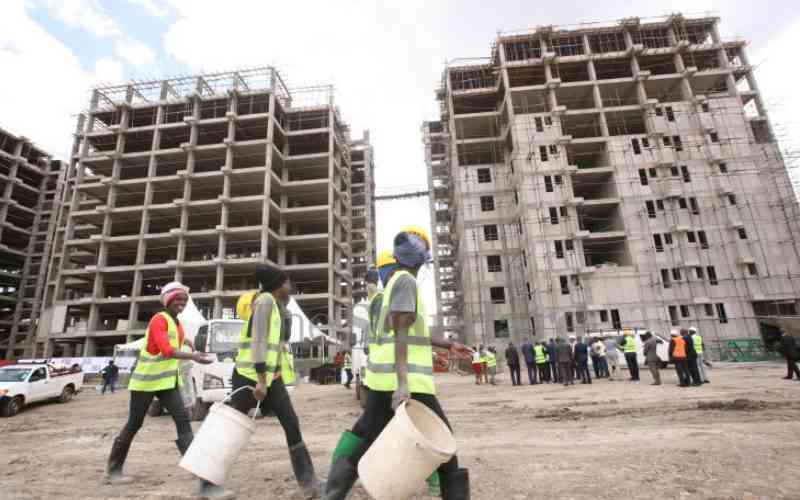Kenya aims to become a middle-income country, providing a high quality life to all its citizens, by 2030. President Uhuru Kenyatta has identified food security, affordable housing, manufacturing and universal healthcare (the Big Four) as the main focus of government investment in the next four years.
To achieve the Big Four, the Government and private investors need to outlay huge amounts of resources whose meaningful rate of return could be long and painstaking.
Industrialisation generally presents immense opportunities to create wealth and raise much-the needed revenue streams to fuel the President’s agenda.
Outside industrial activities in mining and quarrying, oil and gas exploration, electricity and water, building and construction, manufacturing currently presents the most practical, sustainable and quickest means to economic take-off for the African continent in general.
Kenya must invest in a manufacturing revolution or forget the 2030 dream. All government interventions - policy, administrative, and legal - must quickly be aligned to create the enabling environment needed for new manufacturing enterprises and expand existing local initiatives in manufacturing, and to create Kenya as an unbeatable foreign direct investment in Africa.
The manufacturing sector’s contribution to GDP has been shrinking steadily since independence. This trend must be reversed. The sector was growing at about 7 per cent in the 1964/1970 period.
In the 1980/1984 period, it dropped to 4 per cent with a slight rise in growth of up to 6 per cent in 1988 and 5.9 per cent in 1989. In the 1990s, manufacturing contributed to about 13 per cent.
Food products
The Kenya National Bureau of Statistics estimates that manufacturing has been contributing to a less than optimal 10 per cent per annum to GDP in the past 10 years.
The Government estimates that manufacturing shall contribute about 15 per cent of GDP by 2022 as a Big Four legacy agenda.
This target should be more ambitious and adjusted upwards by 2022 and a long-term blueprint put in place to increase manufacturing’s contribution to about 30 per cent of GDP by 2030. Currently, the bulk of the manufacturing sector relates to food products, at 43 per cent.
The rest is distributed as follows in percentage points: beverage and tobacco 9, textiles and apparel 8, chemicals 7, fabricated metals 7, rubber and plastic 5, non-metallic minerals 4, print media 4, paper 2, basic pharmaceuticals 1 and others, which include leather, wood and furniture, transport equipment, and machinery, about 8.
The Government should target quick wins through expansion of agro-processing and manufacturing contemporaneously with the establishment of new manufacturing sub-sectors in computer and electronic product manufacturing, electronic equipment, appliance and component manufacturing and ICT driven manufacturing generally.
More citizens
The teaching and training curriculum should be refocused to creation of skills and capacity-building for entrepreneurship and self-employment.
Stay informed. Subscribe to our newsletter
Youth should receive business training at an early age, and existing skills upgraded.
The Government should invest in the promotion of science, technology, engineering, entrepreneurship, vocational and on-the-job training.
Manufacturers can be incentivised to provide internships and apprenticeships, and employ more youths through tax credits and other forms of compensatory mechanisms.
County governments can also extend waivers of rates and certain licences in respect of manufacturing ventures that operate and employ persons within their jurisdiction. The Government should bring the cost of doing business down, address cost-effectiveness challenges such as energy, access to roads and ports, security, financing, bureaucratic restrictions, corruption, dispute settlement, property rights and duplication of licensing across counties. Manufacturers should reciprocate by employing more citizens and not always see this as a way to greater profitability.
The Government should expand the size of the supply market by easing trade restrictions, integrating regional trade networks, increasing the country’s ability to develop sophisticated products, and lifting the barriers to small and medium-size business growth and development.
Manufacturing requires heavy investment and should be driven by the private sector. Policy makers should facilitate access to finance, especially for SMEs, by developing and effectively managing instruments appropriate to the stage of development (loans, guaranties and venture funds) in critical sectors.
The Government should address the poor risk perception that scares away potential investors or sets excessive returns expectations.
Policy makers should also mobilise domestic resources, curb illicit flows, appropriately manage state revenues and invest to stimulate inclusive economic growth.
Mr Mamboleo is an advocate and a consultant at the International Economic Law Centre
 The Standard Group Plc is a
multi-media organization with investments in media platforms spanning newspaper
print operations, television, radio broadcasting, digital and online services. The
Standard Group is recognized as a leading multi-media house in Kenya with a key
influence in matters of national and international interest.
The Standard Group Plc is a
multi-media organization with investments in media platforms spanning newspaper
print operations, television, radio broadcasting, digital and online services. The
Standard Group is recognized as a leading multi-media house in Kenya with a key
influence in matters of national and international interest.
 The Standard Group Plc is a
multi-media organization with investments in media platforms spanning newspaper
print operations, television, radio broadcasting, digital and online services. The
Standard Group is recognized as a leading multi-media house in Kenya with a key
influence in matters of national and international interest.
The Standard Group Plc is a
multi-media organization with investments in media platforms spanning newspaper
print operations, television, radio broadcasting, digital and online services. The
Standard Group is recognized as a leading multi-media house in Kenya with a key
influence in matters of national and international interest.









